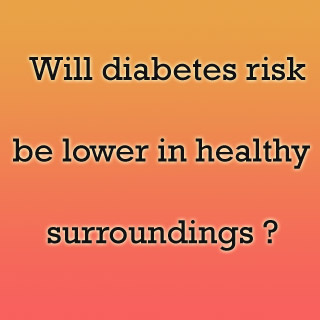
The authors provide background information by mentioning that the worldwide epidemic of type 2 diabetes mellitus is largely driven by the combined rise in obesity, intake of energy-dense or nutrient-poor foods and physical inactivity.
Interventions to decrease danger on the individual level, counting surgery, medication and behavior change have apparently had varied outcomes. Large-scale behavior alteration could be required to undo the diabetes epidemic, but such a transformation could be hard to attain and may be unsustainable if the nearby atmosphere is not helpful.
Around 2,285 adults from age 45 to 84 were at first scanned from 2000 to 2002 by Amy H. Auchincloss, Ph.D., M.P.H., of Drexel University School of Public Health, Philadelphia, and colleagues. Blood glucose levels were acquired from study participants at baseline and at three follow-up assessments, during which other individual characteristics were also examined. They were diet, body mass index [BMI] and physical activity levels. The contestants were from three of the sites in the Multi-Ethnic Study of Atherosclerosis (MESA) for which surrounding level data were acquired: Baltimore; Forsyth County, N.C.; and New York City/Bronx.
Measures of neighborhood resources were acquired from a different examination, the Community Survey, in which other inhabitants of the same neighborhoods which is claimed to be the region within a 20-minute walk or a mile from their homes, rated the fittingness of their environment for physical activity and access to healthy foods. For example, they were asked if it was enjoyable or easy to walk in their neighborhood, and whether a huge, high-quality selection of fruits, vegetables and other low-fat foods was accessible. Scores for physical activity and healthy foods were measured for every neighborhood on scales of one to five i.e. with five standing for the healthiest regions.
Over a midpoint of five years of follow-up, around 233 of the 2,285 participants got diabetes. It was seen that average neighborhood scores were around 3.68 for physical activity and about 3.36 for healthy foods.
The authors commented, “Better neighborhood resources, determined by a combined score for physical activity and healthy foods, were associated with a 38 percent lower incidence of type 2 diabetes.”
The authors mentioned it was akin to the drop in the threat seen among individuals whose BMI was apparently five points lower.
The authors remarked, “The association remained statistically significant after further adjustment for individual dietary factors, physical activity level and body mass index.”
The escalating frequency of type 2 diabetes in the past 30 years supposedly makes it vital to recognize environmental features that may alleviate threat.
The authors quoted, “Current efforts to foster health-promoting environments include designing and modifying physical environments, such as zoning residential neighborhoods to require safe sidewalks, creating parks and attractive public green spaces and improving public transportation so that residents rely less on their cars; supporting fresh-food farmers’ markets in low-income, urban neighborhoods; and assisting stores in those neighborhoods in improving their selection of healthy foods.”
It is said that there is unlikely to be a panacea for the obesity epidemic and rising epidemic of type 2 diabetes. However, altering the environments so that healthier behaviors and lifestyles can be easily chosen may be one of the key steps in arresting and reversing these epidemics.
The study was published in the Archives of Internal Medicine, one of the JAMA/Archives journals.
